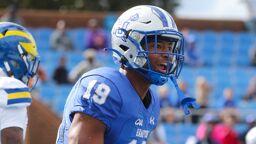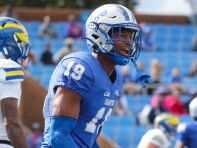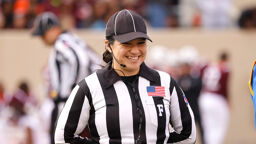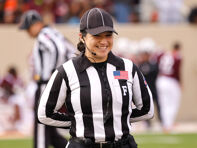When the Pro Football Hall Of Fame announced it would increase the number of inductees in 2020, in recognition of its Centennial Celebration, my mind went to one name: Jerry Smith.
For decades there have been players and coaches who have failed to get the attention of the Pro Football Hall Of Fame selection committee. Yet Smith’s absence from the Hall is particularly glaring not just because of what he did on the field, and not just how that matches with (and exceeds) the production of other players who are in the Hall.
What makes Smith’s exclusion so egregious: One long-time Hall Of Fame voter told me recently that Smith, to the best of his knowledge, has never been a finalist.
NFL record-setter. Record stood for 27 years. On-field production exceeded many Hall Of Fame players. Never a finalist.
Get off the sidelines and into the game
Our weekly playbook is packed with everything from locker room chatter to pressing LGBTQ sports issues.
With Smith talking publicly in the mid-1980s about having AIDS (and many people knowing he was gay), you have to wonder what the voters were thinking at the time. While voters today wouldn’t hold that against him, becoming eligible in the middle of the AIDS scare certainly didn’t help Smith with voters then.
Jerry Smith is the most-deserving, most-forgotten player on the Hall Of Fame’s 2020 list for reasons on and off the field.
The increase in senior inductees next year is designed to catch some of the people who have fallen through the cracks. The 2020 class is being expanded specifically for people like Smith, who was intentionally quiet and avoided interviews and the limelight during his career, reportedly for fear he would be outed as gay.
Smith flying under the radar during his career was a survival tactic as he hoped to hide the fact he was gay for fear of reprisal. What role his sexual orientation had in swaying voters during a fear-filled AIDS crisis in the mid-1980s we can only assume.
Now, over 30 years after his untimely death, and without a champion waving a flag for No. 87, in this special year designed to honor the forgotten past, it’s time for the blue-ribbon panel of senior selectors to bring the conversation about Jerry Smith into the room.
NFL leader in tight end touchdowns for 27 years
Of all of Smith’s accomplishments, one in particular stands out from the rest like no other forgotten candidate: 60 career touchdowns.
When he retired from football in 1977, it was an NFL record for tight ends. He held the league record for 27 years, until Shannon Sharpe edged him out in 2002. Sharpe ended his career with 62 scores — just two more than Smith — and he’s now in the Hall Of Fame.
There aren’t many NFL records for any offensive position that one person held for 27 years, particularly when that record was set in the 1970s. To the best of my knowledge, this is the only one.
Despite the barrage of passing attacks that have taken hold in the NFL, Smith is still sixth in league history for touchdowns scored by a tight end — higher than any Hall Of Fame inductee not named Gonzalez or Sharpe.
That number wasn’t just good for the largely under-utilized tight end position. When he retired, Smith was 17th on the NFL’s all-time receiving touchdown list regardless of position, and most of those other players — playing receiver and getting more touches — have a yellow jacket.
Not many tight ends get into the Hall Of Fame — only nine to date. Given what he did on the field, Smith should be No 10.
This year there are six tight ends being considered as modern-era nominees. To be sure, all of them are likely long-shots to make the Hall. Still, how does Smith stack up against these players who benefitted from robust passing games?
CAREER TOUCHDOWNS
60 Jerry Smith
54 Wesley Walls
53 Dallas Clark
50 Ben Coates
49 Keith Jackson
37 Jeremy Shockey
33 Brent Jones
Smith tops all of the current modern-era tight end nominees in touchdowns, and he did it playing 14-game seasons.
Smith’s career touchdown accomplishment alone is Hall Of Fame worthy.
Smith didn’t just catch touchdowns
Not to upset Buddy Ryan, Smith did more than just catch touchdowns.
When Smith retired in 1977, he was also second all-time in career receptions by a tight end. His 421 career receptions were only six behind the then-No. 1: Hall Of Famer Mike Ditka.
That career receptions total was, at the time, third in the history of Washington, behind receivers Art Monk and Charley Taylor. Both Monk and Taylor are in the Pro Football Hall Of Fame.
While Smith’s 13.1 yards per reception may not be top-of-class, it’s still better than various Hall Of Famer tight ends — including Kellen Winslow and Ozzie Newsome — as well as candidates on the radar screen — including Ben Coates, Dallas Clark, Jay Novacek and Todd Christiansen.
“From 1966 to 1970, Jerry Smith caught more passes for more yards than any tight end in football,” NFL Network’s commentator noted.
Couple his receiving numbers with his other statistics, and you come up with the most eligible tight end in consideration — senior-class or modern-era — on any ballot for 2020.
While Smith was known for his pass-catching, he could also block. As former Washington president Bruce Allen said of Smith, he was “a true tight end, always with a hand on the ground.”
As NFL Network’s commentator noted: “In Allen’s system his main responsibility in Allen’s system was blocking. Despite Smith’s diminished numbers, he helped Washington reach the postseason for the first time in nearly 30 years.”

Debunking the All-Decade Team allure
One reason offered for keeping Smith out of the Hall Of Fame is that he was never on an all-decade team. About 75% of inductees have been named to an all-decade team.
The problem for a guy like Smith is that the height of his career evenly spanned two decades. Drafted literally in the middle of the Sixties (1965 to be exact), he topped 30 receptions in a season (a solid number for a tight end in that era) four years in the Sixties and three years in the Seventies.
He caught 56% of his receiving yards in the 1960s, 44% in the ‘70s.
If someone created an “All-Decade team” from 1966 to 1975, Smith would be selected as the tight end.
Instead, the All-Decade Team tight end for the 1960s is John Mackey, who was drafted in 1963, two years ahead of Smith, and is in the Hall Of Fame. The 1970s All-Decade tight end, Dave Casper, and the 1970s second-team tight end, Charlie Sanders, are also in the Hall.
How do Smith’s numbers match up against these three tight ends from the All-Decade teams of his era?
Career Stats
| Player | TDs | Receptions | Rec Yds |
| Smith | 60 | 421 | 5,496 |
| Casper | 52 | 378 | 5,216 |
| Mackey | 38 | 331 | 5,236 |
| Sanders | 31 | 336 | 4,817 |
Stated simply: In career touchdowns, receptions and receiving yards, Smith leads all three All-Decade Hall of Fame tight ends of his era in every single category.
And as a bonus: He’s got more touchdowns than Ditka, Newsome and Winslow, too.
In career touchdowns, receptions and receiving yards, Jerry Smith leads all three All-Decade Hall of Fame tight ends of his era in every single category.
What other NFL players and coaches have said about him
Smith’s quantifiable statistics speak for themselves. Yet a player is more than just his statistics. That’s certainly the case with Smith.
When coach George Allen was tasked with compiling Washington’s All-Time team about a decade after Smith’s retirement, he said Smith was the most obvious pick of all.
“The easiest position for me to pick of all 22 is tight end,” Allen said in selecting Smith as the franchise’s all-time tight end. “He has it hands-down. He was an undersized tight end who could block.”
In addition, Smith’s name resides in the team’s Ring Of Fame, the only tight end included.
All-Pro running back Calvin Hill, talking with Sports Illustrated a few years ago, gushed about his time playing with Smith.
“I never played with a better tight end than Jerry Smith,” Hill said. It might be just the opinion of one guy, but that one guy was someone who ran behind Smith’s blocks and was also a teammate of Ditka and Newsome, two tight ends in the Hall Of Fame.
Jerry’s contribution wasn’t just on the field, according to Hill: “When I got to Washington, I could see there was an element of trust in that locker room, and he was a very important part of it.”
For Hall Of Fame quarterback Sonny Jurgensen, Smith was everything you wanted in a tight end. Smith, regarded as a “clutch player,” made sure every reception counted.
“He became a go-to guy for me,” Jurgensen told the NFL Network a few years ago. “He was outstanding. When you needed a play to be made, you knew that you could throw the ball to him and some way, somehow, he was going to catch the thing.”
Many of his former teammates and people in and around the NFL talked to the NFL Network about Smith, his legacy, and why he should be in the Hall Of Fame for A Football Life: Jerry Smith, which you can watch here:
In the 1980s, homophobia and AIDS kept Smith from some ballots
It’s important to address the pink elephant in the room: Smith was gay and died of complications associated with AIDS in 1986, at the height of the AIDS scare. He was the first professional athlete whose death was linked to the disease.
I don’t believe for a second that voters today care about any of that. But at least some voters in the 1980s — at the height of the AIDS crisis — very much did care. To deny that is to deny history.
Despite Smith trying to keep his being gay a secret, it seems it was very much an open secret. Many of his former teammates have talked publicly about that since, saying they knew about him.
Brig Owens, Smith’s former roommate and a safety for Washington, told NFL Network several years ago that if it weren’t for homophobia, Smith would have been inducted into the Hall Of Fame years ago.
Late in Smith’s career, NFL head of security Jack Danahy talked publicly about gay players being a threat to NFL security, equating them with spies and their behavior with espionage.
“If there actually were a homosexual in the league, which I have no evidence there is, if you have a homosexual he’s always subject to possible compromise,” Danahy said. “That’s been a standard situation in world activities in espionage, in the history of espionage activities… and used against their better interests.”
In the 1980s, when Smith went public about having AIDS, some people were proposing laws that would mandate AIDS victims get tattoos on their hands, so that people could more easily avoid touching them (yes, this literally happened). Some doctors refused to treat them (yes, this happened too). The outright discrimination faced by gay men — and in particular gay men with AIDS — was very real and is well-documented.
His exclusion from the Hall Of Fame has yet to be remedied by those same voters.
If you doubt the fear Smith faced in the mid-1980s, please watch this NFL Network video as people around him talk about the world he lived in.
Again, thankfully, those times have past. Hall Of Fame voters today would not take Smith’s sexual orientation or cause of death into consideration.
Yet his exclusion from the Hall Of Fame has yet to be remedied by those same voters.
Smith should not be considered for the Hall Of Fame because he’s gay. Period. While he would be the first openly gay person in the Hall, its his on-field performance that demands voters’ attention.
Yet his courage — speaking publicly about having AIDS at the height of the AIDS crisis in the mid-1980s — is certainly worthy of accolades.
“He would want it to be because of his performance,” Owens told Fox Sports a couple years ago. “All you had to do was watch him play.”
The fact that it is likely that his sexual orientation and affliction with AIDS likely affected his induction in the 1980s should be cause for re-evaluation today.
It’s time to bring Jerry Smith into the 2020 selection room
No doubt there are people across football who believe “their guy” deserves another shot. And many do deserve consideration.
The voters on the selection committee have never had the much-needed conversation about Smith, why he deserves to be in the Hall Of Fame, and analyzing the real reasons he’s not already there.
What’s most disappointing is that Jerry Smith has never gotten his shot. He’s never been a finalist for the Hall. The voters on the selection committee have never had the much-needed conversation about Smith, why he deserves to be in the Hall Of Fame, and analyzing the real reasons he’s not already there.
The selectors are currently deciding their votes to winnow down the list of senior nominees. Smith is on that ballot, along with a couple hundred players. Given the expanded 2020 class, and Smith being left out of the conversation for so long, I hope voters put him on their ballot, include him as a finalist, and finally have that conversation.
Not many tight ends get into the Hall Of Fame — only nine to date. Given what he did on the field, Jerry Smith should be No 10.
For those voters, some added reading:
“One of the most underrated players in NFL history”
The shame of it Hall: Ignoring the Washington Redskins’ Jerry Smith
Friend: Gay Redskins TE Jerry Smith coped with ‘horrendous existence’



































